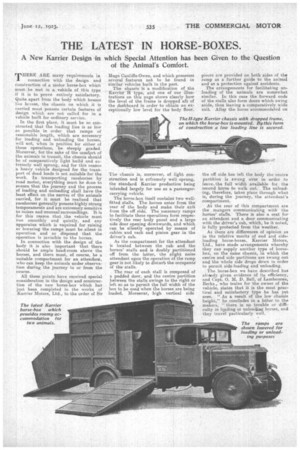THE LATEST IN HORSE-BOXES.
Page 11

If you've noticed an error in this article please click here to report it so we can fix it.
A New Karrier Design in which Special Attention has been Given to the ,Question of the Animal's Comfort.
THERE ARE many requiremente in .1 connection with the design and construction of a motor horse-box which must be met in a. vehicle of this type if it is to prove entirely satisfactory. Quite apart from the body which houses the horses, the chassis on which it is carried must possess certain features of design which are not called for in a vehicle built for ordinary service.
In the first place, it must be so constructed that the loading line is as low as possible in order that ramps of reasonable length, which are necessary for loading and unloading the horses, will not, when in position for either of these operations, be steeply graded: Moreover, for the sake of the comfort, of the animals in transit, the chassis should be of comparatively light build and extremely well sprung, and for this reason a heavy vehicle designed for the transport of dead loads is not suitable for the work. In transporting racehorses by road motor, everything must be done to ensure that the journey and the process of loading and unloading shall have the least effect on the nerves of the animals carried, for it must be realized that racehorses generally possess highly strung temperaments and are extremely sensitive to noises and unusual surrounaings. This for this reason that the vehicle must run smoothly and quietly, and any apparatus which is required for raising or lowering the ramps must be.silent in operation and so .disposed that. the operation is invisible to the horses.
In connection with the design of the body it is also important that there should be ample head-room above the horses, and there must., of course, be a suitable compartment for an attendant, who can keep the animals under observation during the journey to or from the Course.
All these, points have received special consideration in the design and construction of the new horse-box which has just been completed in the works of Karrier Motors, Ltd., to the order of Sir Hugo Cunliffe-Owen, and which possesses several features not to be found in Similar vehicles built in the past. The chassis is a modification of the Karrier "H type, and one of our illustrations on this page shows clearly how the level of the frame is dropped aft of the dashboard in order to obtain an exceptionally low level for the body floor, The chassis is, moreover, of light construction and is extremely well sprung, the standard Karrier production being intended largely for use as a passengercarrying vehicle.
The horse-box itself contains two wellfitted stalls. The horses enter from the rear of the body and make their exit from the off side. The necessary ramps to facilitate these operations form respectively the rear body panel and a large side door opening downwards, and which can be silently operated by means of cables and rack and pinion gear in the driver's cab.
As the vompartment for the attendant is located between the cab and the horses' stalls and is doubly partitioned off from the latter, the slight noise attendant upon the operation of the ramp gear is not likely to disturb the occupants" of the stalls.
The rear of each stall is composed of a padded door, and the centre partition between the stalls swings to the right or left pa as to permit the full width of the box to be used when the horses are being loaded. Moreover, high vertical side pieces are provided on both sides of the ramp as a further guide to the animal and as a protection against accidents.
The arrangements for facilitating unloading of the animals are somewhat similar. In this case the forward ends of the stalls also form doors which swing aside, thus leaving a, comparatively wide exit. After the horse accommodated on the off side has left the body the centre partition is swung over in order to leave, the full width available for the second horse to walk out. The unloading, therefore, takes place through what is, during the journey, the attendant's compartment.
At the rear of this compartment are the mangers communicating. with the horses' stalls. There is also a seat for an attendant and a door communicating with the driver's cab, which, be it noted,. is fully protected from the weather.
As there are differences of opinion as to the relative merits of end and side. loading horse-boxes, Karrier Motors, Ltd,, have Made arrangements whereby they can supply another type of horsebox, on the same chassis, in which the centre and side partitions are swung cot. and the whole side drops down in order to permit side-loading and unloading.
The horse-box we have described has already given evidence of its efficiency, and Capt. 0. M. D. Bell, of Lambourne, Berks., who trains for the owner of the vehicle, states that it is the most practical and satisfactory type he has yet seen. " As a result of the low chassis height.," lie concludes in a letter to the makers, " there is no trouble or diffi.culty in loading or unloading horses, and they travel particularly well, •






























